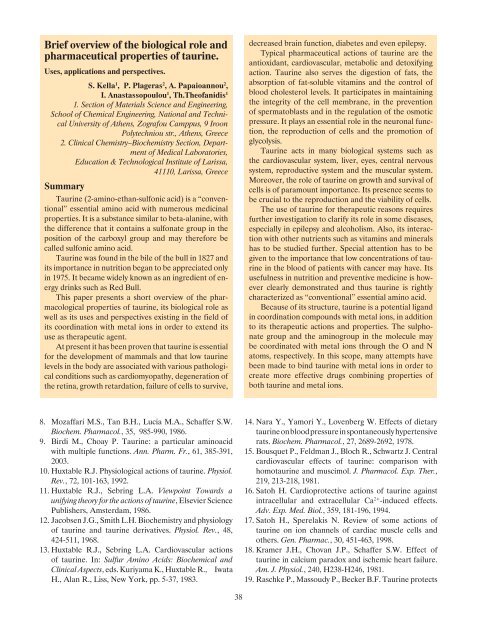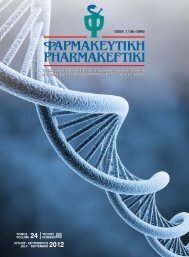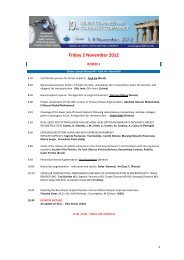Teuxos 01.indd
Teuxos 01.indd
Teuxos 01.indd
- No tags were found...
Create successful ePaper yourself
Turn your PDF publications into a flip-book with our unique Google optimized e-Paper software.
Brief overview of the biological role andpharmaceutical properties of taurine.Uses, applications and perspectives.S. Kella 1 , P. Plageras 2 , A. Papaioannou 2 ,I. Anastassopoulou 1 , Th.Theofanidis 11. Section of Materials Science and Engineering,School of Chemical Engineering, National and TechnicalUniversity of Athens, Zografou Camppus, 9 IroonPolytechniou str., Athens, Greece2. Clinical Chemistry–Biochemistry Section, Departmentof Medical Laboratories,Education & Technological Institute of Larissa,41110, Larissa, GreeceSummaryTaurine (2-amino-ethan-sulfonic acid) is a “conventional”essential amino acid with numerous medicinalproperties. It is a substance similar to beta-alanine, withthe difference that it contains a sulfonate group in theposition of the carboxyl group and may therefore becalled sulfonic amino acid.Taurine was found in the bile of the bull in 1827 andits importance in nutrition began to be appreciated onlyin 1975. It became widely known as an ingredient of energydrinks such as Red Bull.This paper presents a short overview of the pharmacologicalproperties of taurine, its biological role aswell as its uses and perspectives existing in the field ofits coordination with metal ions in order to extend itsuse as therapeutic agent.At present it has been proven that taurine is essentialfor the development of mammals and that low taurinelevels in the body are associated with various pathologicalconditions such as cardiomyopathy, degeneration ofthe retina, growth retardation, failure of cells to survive,decreased brain function, diabetes and even epilepsy.Typical pharmaceutical actions of taurine are theantioxidant, cardiovascular, metabolic and detoxifyingaction. Taurine also serves the digestion of fats, theabsorption of fat-soluble vitamins and the control ofblood cholesterol levels. It participates in maintainingthe integrity of the cell membrane, in the preventionof spermatoblasts and in the regulation of the osmoticpressure. It plays an essential role in the neuronal function,the reproduction of cells and the promotion ofglycolysis.Taurine acts in many biological systems such asthe cardiovascular system, liver, eyes, central nervoussystem, reproductive system and the muscular system.Moreover, the role of taurine on growth and survival ofcells is of paramount importance. Its presence seems tobe crucial to the reproduction and the viability of cells.The use of taurine for therapeutic reasons requiresfurther investigation to clarify its role in some diseases,especially in epilepsy and alcoholism. Also, its interactionwith other nutrients such as vitamins and mineralshas to be studied further. Special attention has to begiven to the importance that low concentrations of taurinein the blood of patients with cancer may have. Itsusefulness in nutrition and preventive medicine is howeverclearly demonstrated and thus taurine is rightlycharacterized as “conventional” essential amino acid.Because of its structure, taurine is a potential ligandin coordination compounds with metal ions, in additionto its therapeutic actions and properties. The sulphonategroup and the aminogroup in the molecule maybe coordinated with metal ions through the O and Natoms, respectively. In this scope, many attempts havebeen made to bind taurine with metal ions in order tocreate more effective drugs combining properties ofboth taurine and metal ions.8. Mozaffari M.S., Tan B.H., Lucia M.A., Schaffer S.W.Biochem. Pharmacol., 35, 985-990, 1986.9. Birdi M., Choay P. Taurine: a particular aminoacidwith multiple functions. Ann. Pharm. Fr., 61, 385-391,2003.10. Huxtable R.J. Physiological actions of taurine. Physiol.Rev., 72, 101-163, 1992.11. Huxtable R.J., Sebring L.A. Viewpoint Towards aunifying theory for the actions of taurine, Elsevier SciencePublishers, Amsterdam, 1986.12. Jacobsen J.G., Smith L.H. Biochemistry and physiologyof taurine and taurine derivatives. Physiol. Rev., 48,424-511, 1968.13. Huxtable R.J., Sebring L.A. Cardiovascular actionsof taurine. In: Sulfur Amino Acids: Biochemical andClinical Aspects, eds. Kuriyama K., Huxtable R., IwataH., Alan R., Liss, New York, pp. 5-37, 1983.14. Nara Y., Yamori Y., Lovenberg W. Effects of dietarytaurine on blood pressure in spontaneously hypertensiverats. Biochem. Pharmacol., 27, 2689-2692, 1978.15. Bousquet P., Feldman J., Bloch R., Schwartz J. Centralcardiovascular effects of taurine: comparison withhomotaurine and muscimol. J. Pharmacol. Exp. Ther.,219, 213-218, 1981.16. Satoh H. Cardioprotective actions of taurine againstintracellular and extracellular Ca 2+ -induced effects.Adv. Exp. Med. Biol., 359, 181-196, 1994.17. Satoh H., Sperelakis N. Review of some actions oftaurine on ion channels of cardiac muscle cells andothers. Gen. Pharmac., 30, 451-463, 1998.18. Kramer J.H., Chovan J.P., Schaffer S.W. Effect oftaurine in calcium paradox and ischemic heart failure.Am. J. Physiol., 240, H238-H246, 1981.19. Raschke P., Massoudy P., Becker B.F. Taurine protects38













